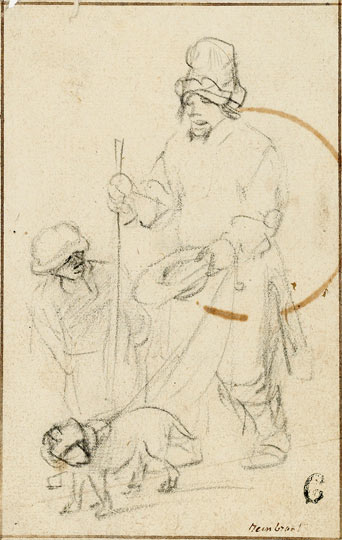Rembrandt drawing found in Scottish attic

A new Rembrandt drawing of a blind beggar with a boy and a dog has been found in a wardrobe in a Scottish attic. Photograph: Christie's
A drawing of a blind beggar by Rembrandt has been found in a Scottish attic, to the astonishment of the house-owner, who had no idea it was even there.
The sketch came to light after the owner found it in a wardrobe and contacted Christie’s. Even from initial photographs, their experts were sure it was by the 17th-century Dutch master.
“We always dream of finding new drawings by the great artists, but it happens very rarely nowadays,” said Benjamin Peronnet, head of old master drawings at Christie’s. “That made this discovery all the more exciting.”
A Blind Beggar With a Boy and a Dog is a black chalk study measuring 13cm by 8.5cm (about 5in by 3.3in). It does not relate to a known painting but the composition is echoed in a drawing in the Kupferstichkabinett, the vast prints and drawings collection in Berlin’s state museum.
Peronnet said: “When we began our research, we were surprised to find an almost identical drawing of a beggar in Berlin – it usually isn’t good news when you find … a similar drawing in a museum, because it can mean that the [discovery] … is only a copy.”
Referring to the Berlin version, Peronnet added: “It had been published as by Rembrandt, although a few scholars had expressed doubts about it. It was clear very quickly to everybody who saw [the discovery] that this was really by Rembrandt and the drawing in Berlin was a copy.”
Beyond the greater fluidity of the discovery, its superiority emerges in details such as the dog’s head and hind legs, the relationship between the beggar’s hand and the hat he holds, and the delineation of the boy’s torso.
Christian Liehm, the Berlin collection’s archivist, confirmed that Holm Bevers, its Rembrandt expert, believes that the Berlin work should now be catalogued as “Rembrandt circle”.
Christie’s Rembrandt was one of six previously unpublished drawings found in the attic. Peronnet said: “[The owner] found a bunch of drawings, prints and other things … He sent us pictures of everything … We of course got excited.”
The other drawings have been attributed to Rembrandt’s pupils and offer a rare insight into his studio practices and how his pupils tried to emulate his drawing style before “freeing themselves from the weight of Rembrandt”, Peronnet said. Those pupils include significant artists such as Ferdinand Bol, whose depiction of Jacob and Rachel reflects the master’s strong influence.
The drawing bears a particularly human touch, defaced by a brown circle like someone’s coffee cup stain. In fact, it is the mark of a studio inkwell. The subject is poignant because the artist died a pauper. His house, paintings and other possessions were sold off.
The drawings are now to be sold by Christie’s on 3 July. The Rembrandt alone is estimated to fetch around £80,000.
By Dalya Alberge
Source: http://www.guardian.co.uk